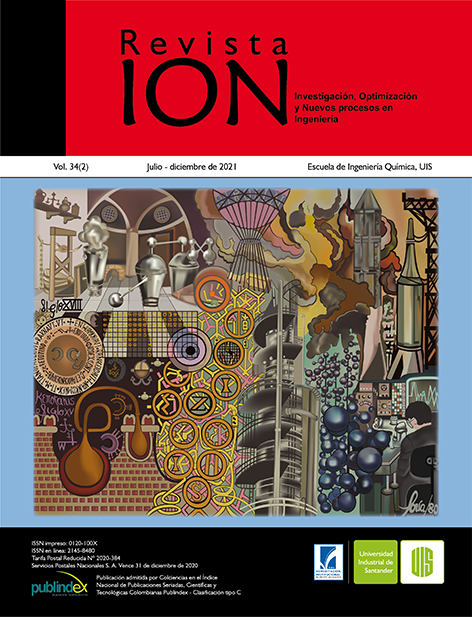Una extensión teórica aplicada a los ácidos puros de cadena larga en la fase líquida para analizar su comportamiento en la fase sólida
Publicado 2021-09-29
Palabras clave
- Expansión térmica del volumen,
- Módulo de masa,
- Fases líquidas y sólidas,
- Ácidos grasos,
- Ecuación de Tait
- Ecuación de Vinet,
- Ecuación de Birch-Murnagham ...Más
Cómo citar
Resumen
En este trabajo, se eligió la ecuación de estado de Peng-Robinson EOS para representar el comportamiento de la fase líquida. Luego, considerando los tres ácidos, Laurico, Palmitico y Esteárico, los coeficientes del módulo de masa se calcularon en tres valores de presión (0,1, 1,0 y 2,0 GPa) y en el rango de temperatura de 350-450 K. De acuerdo con la literatura, resultados para dióxido de carbono, el módulo de masa en la fase líquida esta en la misma línea que el de la fase sólida considerando la variable de temperatura. Con base a esto, en este trabajo el módulo de masa se estimó a tres temperaturas para los tres ácidos en la fase sólida extrapolando los resultados en la fase líquida. Aunque no hay datos experimentales en la literatura, estos resultados parecen ser consistentes con las restricciones termodinámicas y se han obtenido discusiones útiles.
Descargas
Referencias
[2] Devlal K, Khohya K. Analysis of equations of state for metals and rare gas solids. Ind. J. Phys. 2006;80(8):801-5.
[3] Vinet P, Rose JH, Ferrante J, Smith JR. Universal features of the equation of state of solids. J. Phys. 1989;1(11):1941.
[4] Birch F. Elasticity and constitution of the Earth's interior. J. Geo. Res. 1952;57(2):227-86.
[5] Kholiya K. High pressure isothermal equation of state for nanomaterials. Ind. J. Phys. 2013;87(4):339-43.
[6] Suzuki A. Pressure–volume–temperature equation of state of ε–FeOOH to 11 GPa and 700 K. J. Min. Petrol. Sci. 2016;111(6):420-4.
[7] Poling BE, Grens EA, Prausnitz JM. Thermodynamic properties from a cubic equation of state: avoiding trivial roots and spurious derivatives. Ind. Eng. Chem. Process Des. Dev. 1981;20(1):127-30.
[8] Jayanti PC, Venkatarathnam G. Identification of the phase of a substance from the derivatives of pressure, volume and temperature, without prior knowledge of saturation properties: Extension to solid phase. Fluid Pha. Equi. 2016;425:269-77.
[9] Stacey FD. Theory of thermal and elastic properties of the lower mantle and core. Phys. Earth Planet. Int. 1995;89(3-4):219-45.
[10] Kumar S, Sharma SK, Pandey OP. Analysis of thermodynamic properties in the limit of ininite pressure. HTHP. 2015;44(5).
[11] Anderson OL, Isaak DG. The dependence of the Anderson-Grüneisen parameter δT upon compression at extreme conditions. J. Phys. Chem. Solids. 1993;54(2):221-7.
[12] Anderson OL, Anderson OL. Equations of state of solids for geophysics and ceramic science. Estasdos Unidos: Oxford University Press; 1995.
[13] Kholiya K, Chandra J, Verma S. Analysis of Equation of States for the Suitability at High Pressure: MgO as an Example. Sci. World J. 2014.
[14] Júnior MRF, Rocha MAP, Rocha NRDAF, Pereira WA, Merlo NP. Thermal expansivity coefficient (α) and isothermal bulk modulus (KT) obtained for fatty acids in liquid phase to estimate the Anderson-Grüneisen parameter (δT). International J. Chem. Stu. 2018;2(6):1-5.
[15] Heberlein DC, Adams ED, Scott TA. Thermal expansion and isothermal compressibility of solid nitrogen. J. Low Temp. Phys. 1970;2(3):449-63.
[16] Jacobs MHG, Oonk HAJ. A realistic equation of state for solids. The high pressure and high temperature thermodynamic properties of MgO. Calphad. 2000;24(2):133-47.
[17] Kholiya K. High pressure equation of state for nano materials. IJPAP. 2013;51(02):94-7
[18] Yaws CL. Yaws' Handbook of thermodynamic and physical properties of chemical compounds. Knovel; 2003.
[20] Mao Z, Fan D, Lin JF, Yang J, Tkachev SN, Zhuravlev K, et al. Elasticity of single-crystal olivine at high pressures and temperatures. Earth and Planet. Sci. Letters. 2015;426:204-15.
[21] Pandey AK, Rai HK, Pandey BK, Srivastava AP, Singh CK. Validity of High Pressure Isothermal Equation of State for Carbon Nanotubes. Res. J. Phys. 2015;9(1):11-20.
[22] Amoozandeh Z, Yousefi F. Application of the Ihm-Song-Mason equation of state and its extension to copolymers using minimum input parameter. HTHP. 2015;44(5):351-67.
[23] Gal J. Cascading crystallographic transitions α→ ω→ β→ β’→ β" and melting curve of elemental zirconium. Physica B: Condensed Matter. 2021;613:412979.
[24] Singh S, Lang L, Dovale-Farelo V, Herath U, Tavazohi P, Coudert FX, et al. MechElastic: A Python Library for Analysis of Mechanical and Elastic Properties of Bulk and 2D Materials. Computer Phys. Comm. 2021;267:108068.
[25] Latimer K, Dwaraknath S, Mathew K, Winston D, Persson KA. Evaluation of thermodynamic equations of state across chemistry and structure in the materials project. npj Computational Materials. 2018;4(1):1-7.
[26] Rault J. The modified van der Waals equation of state. European Phys. J. B. 2019;92(1):1-32.


